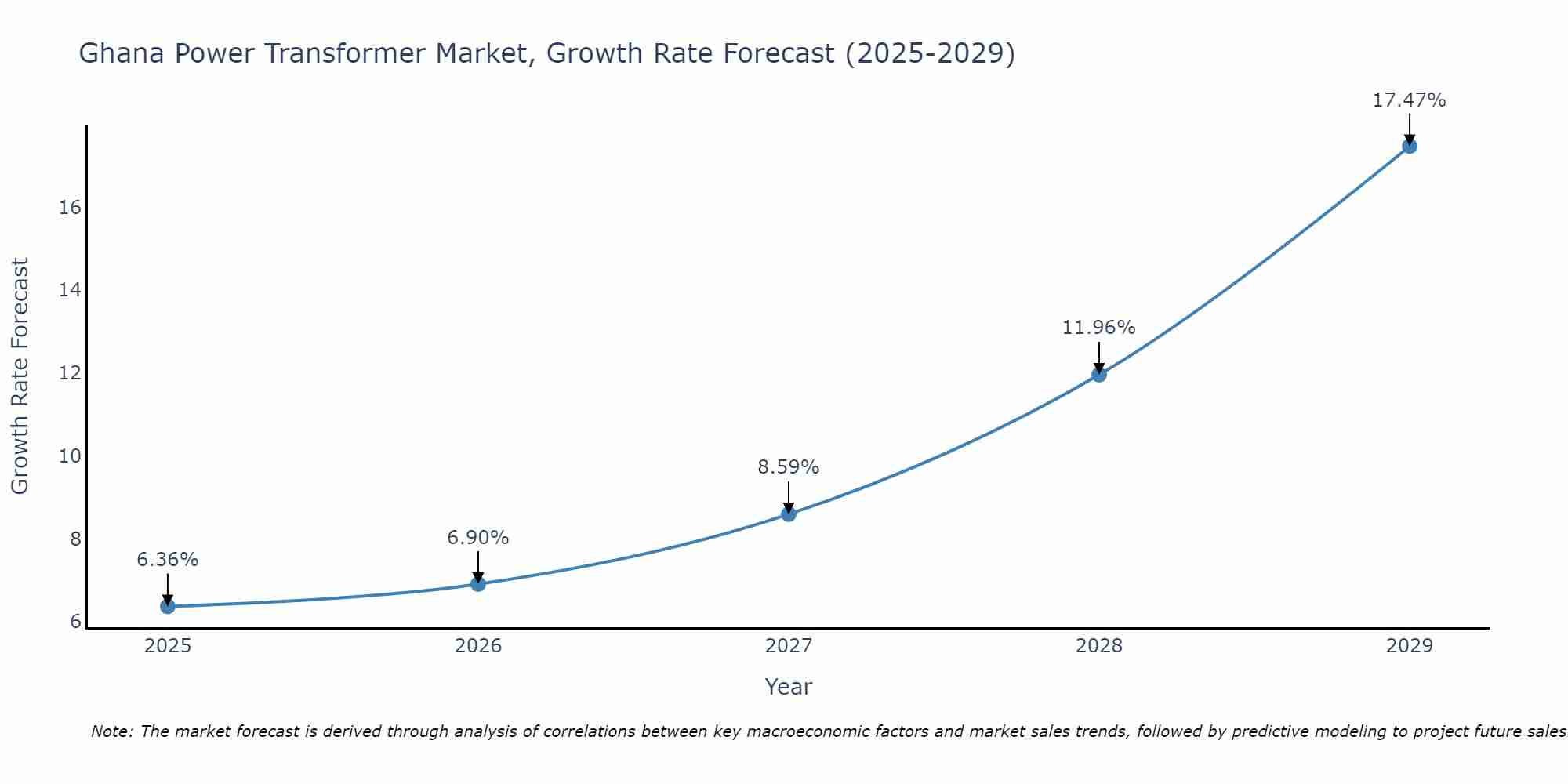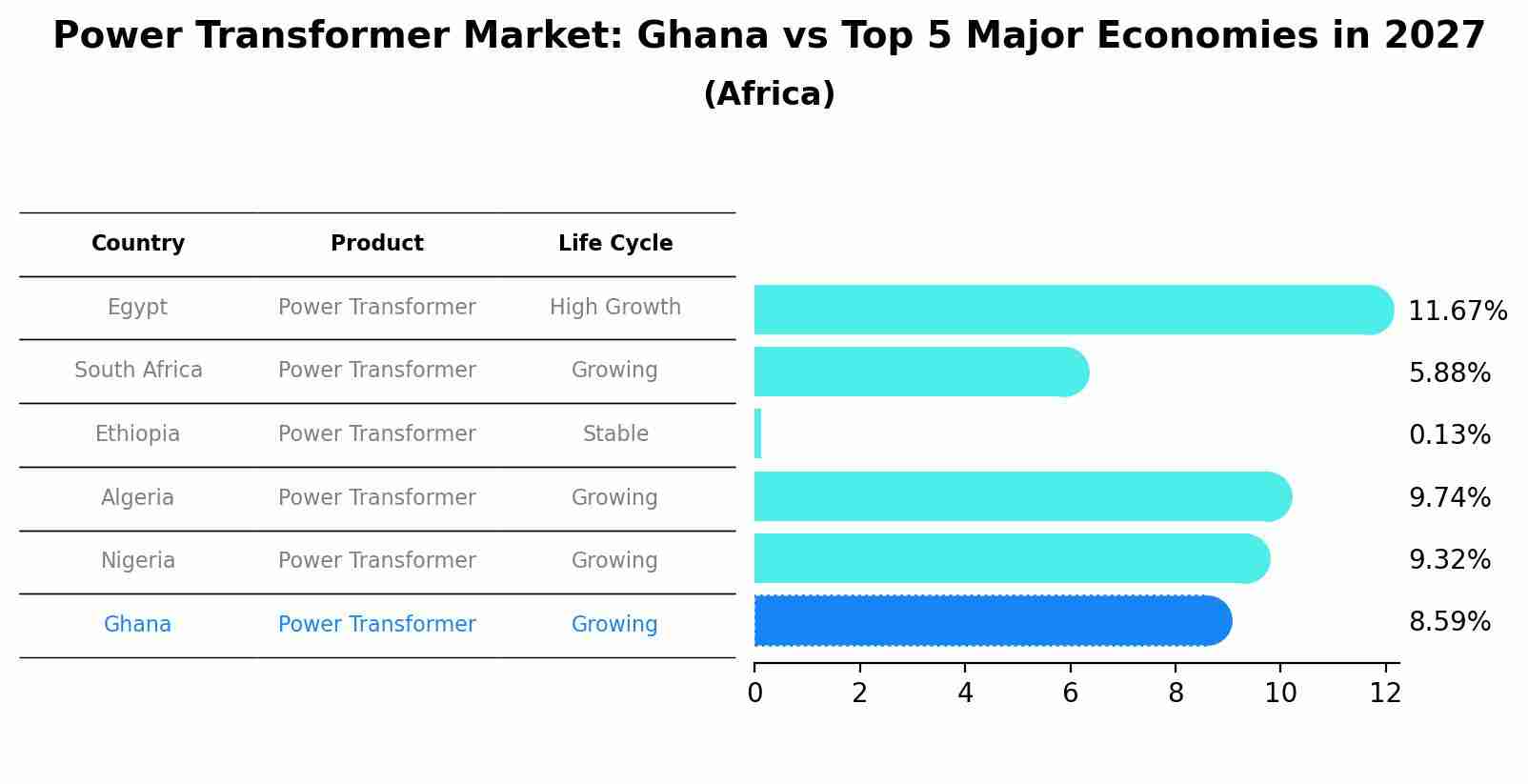Ghana Power Transformer Market (2025-2031) Outlook | Trends, Revenue, Value, Analysis, Share, Companies, Growth, Size, Forecast & Industry
| Product Code: ETC268976 | Publication Date: Aug 2022 | Updated Date: Aug 2025 | Product Type: Market Research Report | |
| Publisher: 6Wresearch | Author: Ravi Bhandari | No. of Pages: 75 | No. of Figures: 35 | No. of Tables: 20 |
Ghana Power Transformer Market Size Growth Rate
The Ghana Power Transformer Market is likely to experience consistent growth rate gains over the period 2025 to 2029. Commencing at 6.36% in 2025, growth builds up to 17.47% by 2029.

Power Transformer Market: Ghana vs Top 5 Major Economies in 2027 (Africa)
In the Africa region, the Power Transformer market in Ghana is projected to expand at a growing growth rate of 8.59% by 2027. The largest economy is Egypt, followed by South Africa, Ethiopia, Algeria and Nigeria.

Ghana Power Transformer Market Overview
The power transformer market in Ghana is driven by infrastructure development, industrialization, and urbanization, leading to increased demand for electricity transmission and distribution.
Drivers of the market
The expansion of power generation capacity, the modernization of transmission and distribution infrastructure, and the increasing focus on energy efficiency are driving the growth of Ghana power transformer market. Power transformers play a crucial role in voltage regulation, power distribution, and grid stability, supporting reliable electricity supply and infrastructure development, thus stimulating market growth.
Challenges of the market
Supply chain risks and technology adoption pose significant challenges to the Ghana power transformer market. Power transformers are critical components in electrical substations and transmission networks, facilitating the efficient and reliable transmission of electricity over long distances. However, ensuring a consistent supply of high-quality transformers requires robust supply chain management and quality control measures. Fluctuations in raw material prices and availability, as well as logistical challenges in transportation and delivery, can disrupt production schedules and increase manufacturing costs. Moreover, adopting new transformer technologies, such as smart transformers and renewable energy integration solutions, requires overcoming technical, regulatory, and financial barriers. Collaborating with transformer manufacturers, suppliers, and regulatory authorities to address supply chain risks and promote technology adoption is essential for overcoming these challenges and ensuring the reliability and resilience of the power grid in Ghana.
Government Policy of the market
Recognizing the essential role of power transformers in electricity transmission and distribution networks, the government of Ghana has instituted policies to support the power transformer market. These policies aim to promote investment in transformer manufacturing capacity, adoption of efficient and environmentally friendly transformer technologies, and deployment of smart transformer solutions. Additionally, the government emphasizes the importance of promoting quality standards, ensuring grid reliability, and facilitating access to transformers for utilities and infrastructure developers. By fostering collaboration between stakeholders and providing incentives for local production, the government seeks to enhance the resilience and efficiency of the power transformer market in Ghana.
Key Highlights of the Report:
- Ghana Power Transformer Market Outlook
- Market Size of Ghana Power Transformer Market, 2024
- Forecast of Ghana Power Transformer Market, 2031
- Historical Data and Forecast of Ghana Power Transformer Revenues & Volume for the Period 2021-2031
- Ghana Power Transformer Market Trend Evolution
- Ghana Power Transformer Market Drivers and Challenges
- Ghana Power Transformer Price Trends
- Ghana Power Transformer Porter's Five Forces
- Ghana Power Transformer Industry Life Cycle
- Historical Data and Forecast of Ghana Power Transformer Market Revenues & Volume By Rating for the Period 2021-2031
- Historical Data and Forecast of Ghana Power Transformer Market Revenues & Volume By Low (5 MVA to 100 MVA) for the Period 2021-2031
- Historical Data and Forecast of Ghana Power Transformer Market Revenues & Volume By Medium (100 MVA to 500 MVA) for the Period 2021-2031
- Historical Data and Forecast of Ghana Power Transformer Market Revenues & Volume By High (above 500 MVA) for the Period 2021-2031
- Ghana Power Transformer Import Export Trade Statistics
- Market Opportunity Assessment By Rating
- Ghana Power Transformer Top Companies Market Share
- Ghana Power Transformer Competitive Benchmarking By Technical and Operational Parameters
- Ghana Power Transformer Company Profiles
- Ghana Power Transformer Key Strategic Recommendations
Frequently Asked Questions About the Market Study (FAQs):
1 Executive Summary |
2 Introduction |
2.1 Key Highlights of the Report |
2.2 Report Description |
2.3 Market Scope & Segmentation |
2.4 Research Methodology |
2.5 Assumptions |
3 Ghana Power Transformer Market Overview |
3.1 Ghana Country Macro Economic Indicators |
3.2 Ghana Power Transformer Market Revenues & Volume, 2021 & 2031F |
3.3 Ghana Power Transformer Market - Industry Life Cycle |
3.4 Ghana Power Transformer Market - Porter's Five Forces |
3.5 Ghana Power Transformer Market Revenues & Volume Share, By Rating, 2021 & 2031F |
4 Ghana Power Transformer Market Dynamics |
4.1 Impact Analysis |
4.2 Market Drivers |
4.2.1 Increasing demand for electricity in Ghana due to population growth and economic development |
4.2.2 Government initiatives to improve and expand the power infrastructure in the country |
4.2.3 Growth in renewable energy projects driving the need for power transformers |
4.2.4 Technological advancements leading to the adoption of more efficient and reliable transformers |
4.3 Market Restraints |
4.3.1 Inadequate funding for power infrastructure projects |
4.3.2 Political instability impacting investment and project implementation |
4.3.3 Lack of skilled workforce for maintenance and operation of power transformers |
4.3.4 Fluctuating raw material prices affecting the cost of manufacturing transformers |
5 Ghana Power Transformer Market Trends |
6 Ghana Power Transformer Market, By Types |
6.1 Ghana Power Transformer Market, By Rating |
6.1.1 Overview and Analysis |
6.1.2 Ghana Power Transformer Market Revenues & Volume, By Rating, 2021-2031F |
6.1.3 Ghana Power Transformer Market Revenues & Volume, By Low (5 MVA to 100 MVA), 2021-2031F |
6.1.4 Ghana Power Transformer Market Revenues & Volume, By Medium (100 MVA to 500 MVA), 2021-2031F |
6.1.5 Ghana Power Transformer Market Revenues & Volume, By High (above 500 MVA), 2021-2031F |
7 Ghana Power Transformer Market Import-Export Trade Statistics |
7.1 Ghana Power Transformer Market Export to Major Countries |
7.2 Ghana Power Transformer Market Imports from Major Countries |
8 Ghana Power Transformer Market Key Performance Indicators |
8.1 Average age of power transformers in operation |
8.2 Frequency of power outages due to transformer failures |
8.3 Percentage of renewable energy sources in the overall energy mix |
8.4 Energy efficiency improvement targets achieved |
8.5 Investment in grid modernization projects |
9 Ghana Power Transformer Market - Opportunity Assessment |
9.1 Ghana Power Transformer Market Opportunity Assessment, By Rating, 2021 & 2031F |
10 Ghana Power Transformer Market - Competitive Landscape |
10.1 Ghana Power Transformer Market Revenue Share, By Companies, 2024 |
10.2 Ghana Power Transformer Market Competitive Benchmarking, By Operating and Technical Parameters |
11 Company Profiles |
12 Recommendations |
13 Disclaimer |
- Single User License$ 1,995
- Department License$ 2,400
- Site License$ 3,120
- Global License$ 3,795
Search
Thought Leadership and Analyst Meet
Our Clients
Related Reports
- Canada Oil and Gas Market (2026-2032) | Share, Segmentation, Value, Industry, Trends, Forecast, Analysis, Size & Revenue, Growth, Competitive Landscape, Outlook, Companies
- Germany Breakfast Food Market (2026-2032) | Industry, Share, Growth, Size, Companies, Value, Analysis, Revenue, Trends, Forecast & Outlook
- Australia Briquette Market (2025-2031) | Growth, Size, Revenue, Forecast, Analysis, Trends, Value, Share, Industry & Companies
- Vietnam System Integrator Market (2025-2031) | Size, Companies, Analysis, Industry, Value, Forecast, Growth, Trends, Revenue & Share
- ASEAN and Thailand Brain Health Supplements Market (2025-2031) | Strategy, Consumer Insights, Analysis, Investment Trends, Opportunities, Growth, Size, Share, Industry, Revenue, Segments, Value, Segmentation, Supply, Forecast, Restraints, Outlook, Competition, Drivers, Trends, Demand, Pricing Analysis, Competitive, Strategic Insights, Companies, Challenges
- ASEAN Bearings Market (2025-2031) | Strategy, Consumer Insights, Analysis, Investment Trends, Opportunities, Growth, Size, Share, Industry, Revenue, Segments, Value, Segmentation, Supply, Forecast, Restraints, Outlook, Competition, Drivers, Trends, Demand, Pricing Analysis, Competitive, Strategic Insights, Companies, Challenges
- Europe Flooring Market (2025-2031) | Outlook, Share, Industry, Trends, Forecast, Companies, Revenue, Size, Analysis, Growth & Value
- Saudi Arabia Manlift Market (2025-2031) | Outlook, Size, Growth, Trends, Companies, Industry, Revenue, Value, Share, Forecast & Analysis
- Uganda Excavator, Crane, and Wheel Loaders Market (2025-2031) | Strategy, Consumer Insights, Analysis, Investment Trends, Opportunities, Growth, Size, Share, Industry, Revenue, Segments, Value, Segmentation, Supply, Forecast, Restraints, Outlook, Competition, Drivers, Trends, Demand, Pricing Analysis, Competitive, Strategic Insights, Companies, Challenges
- Rwanda Excavator, Crane, and Wheel Loaders Market (2025-2031) | Strategy, Consumer Insights, Analysis, Investment Trends, Opportunities, Growth, Size, Share, Industry, Revenue, Segments, Value, Segmentation, Supply, Forecast, Restraints, Outlook, Competition, Drivers, Trends, Demand, Pricing Analysis, Competitive, Strategic Insights, Companies, Challenges
Industry Events and Analyst Meet
Whitepaper
- Middle East & Africa Commercial Security Market Click here to view more.
- Middle East & Africa Fire Safety Systems & Equipment Market Click here to view more.
- GCC Drone Market Click here to view more.
- Middle East Lighting Fixture Market Click here to view more.
- GCC Physical & Perimeter Security Market Click here to view more.
6WResearch In News
- Doha a strategic location for EV manufacturing hub: IPA Qatar
- Demand for luxury TVs surging in the GCC, says Samsung
- Empowering Growth: The Thriving Journey of Bangladesh’s Cable Industry
- Demand for luxury TVs surging in the GCC, says Samsung
- Video call with a traditional healer? Once unthinkable, it’s now common in South Africa
- Intelligent Buildings To Smooth GCC’s Path To Net Zero


















